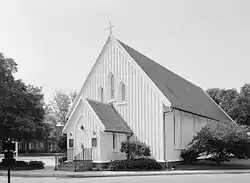Chapel of the Centurion
The Chapel of the Centurion is the oldest continually used wooden military structure for religious services in the United States.[4] It is located inside Fort Monroe, a former military installation located in Hampton, Virginia. The Chapel is named for Cornelius the Centurion, who is believed to be the first Gentile to convert to Christianity.[5]
Chapel of the Centurion | |
 Fort Monroe, Chapel of the Centurion, HABS Photo | |
  | |
| Location | Fort Monroe, Hampton, Virginia |
|---|---|
| Coordinates | 37°00′10″N 76°18′27″W |
| Built | 1856 |
| Architect | Richard Upjohn |
| Architectural style | Carpenter Gothic |
| Part of | Fort Monroe (ID66000912) |
| NRHP reference No. | 10000582[1] |
| VLR No. | 114-0002-0001 |
| Significant dates | |
| Added to NRHP | October 15, 1966, March 28, 2011[2][1] |
| Designated VLR | June 17, 2010[3] |
History
Construction of the chapel began in 1856 and it was consecrated on May 3, 1858. It was designed by architect, Richard Upjohn, in the Carpenter Gothic style.[4] Fort Monroe is no longer an active Army post.
It was individually listed on the National Register of Historic Places in 2011.[1]
Current
The Chapel had an active congregation and On March 25, 2012, Lucious B. Morton was installed as the first civilian and first permanent pastor of the Centurion Interdenominational Church.
See also
References
- "National Register of Historic Places Listings: 3/28/11 through 4/01/11". Weekly List of Actions Taken on Properties. National Park Service. 2011-04-08.
- "National Register Information System". National Register of Historic Places. National Park Service. January 23, 2007.
- "Virginia Landmarks Register". Virginia Department of Historic Resources. Archived from the original on 2013-09-21. Retrieved 19 March 2013.
- Chapel of the Centurion website
- Katherine D. Klepper (n.d.). "National Register of Historic Places Inventory/Nomination: Chapel of the Centurion" (PDF). Virginia Department of Historic Resources. and Accompanying four photos
External links
- Chapel of the Centurion website
- Fort Monroe, Chapel of the Centurion, Off Ruckman Road, Hampton, Hampton, VA: 15 photos, 4 color transparencies, 3 measured drawings, 10 data pages, and 2 photo caption pages at Historic American Buildings Survey

